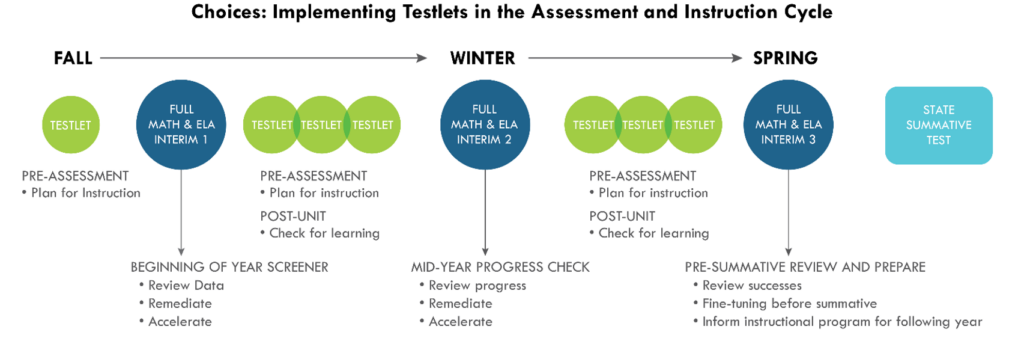Testlets can be selected by educators to assess specific content or all content in a course. Assessing a single reporting category provides focused information on content just presented or to understand the best path in lesson design and delivery. Used formatively, the just-in-time information allows both educators and students to efficiently understand a targeted learning status since all items are related to a single reporting category.
According to Wainer and Kiely (1987, p. 190), testlets are “a group of items related to a single content area that is developed as a unit and contains a fixed number of predetermined paths that an examinee may follow.” An assessment might enable educators to select from a small list of pre-determined, reporting-level testlet assessments in the same content areas and grades assessed in a longer test. Each testlet is comprised of a set of items that produce reliable and valid results of the outcomes in the reporting category. Reports can be available at the reporting-category level, and at the content-area standards level as well. In planning for assessment, it is important to consider the reason for testing students, as well as the time investment teachers and students are making and the data generation that is desired. So, one possible question is, when might a full interim assessment or the testlets be the better choice?
Those using DRC BEACON for interim assessment purposes will find that a full English language arts (ELA) Test or mathematics test will provide more comprehensive data, across all content-area reporting categories. A full DRC BEACON ELA test is approximately 70–90 minutes while the mathematics test is approximately 45–60 minutes. For many classrooms a full interim assessment is possibly best administered at the start of the year, and/or to mark growth and progress over time; for example, at specific points in the school year. It might be used for screening or monitoring for specific purposes.
In a second option to consider, a testlet might best be selected just before or after a related unit of study. Teachers can utilize domain-specific testlets in-between instructional events to assess learning as frequently as needed. This will allow for progress monitoring and can support students who may need remediation or acceleration individually or in small groups within the classroom. These shorter, targeted testlets between full cycles may also be helpful used as a pre-assessment.

DRC BEACON ELA testlets will take approximately 10–14 minutes, except for Reading which takes longer with the inclusion of passage-based items. Mathematics testlets take approximately 15–20 minutes. The data from a testlet will allow educators and students to efficiently understand a targeted learning status since all items are related to a content subset via a single reporting category. With DRC BEACON, all testlets in a content area, taken over 30 days, will also provide a score equivalent to a full test.

Do educators have the data they need to differentiate easily and effectively? Since no two students are identical and to make the most of their time, teachers need a clear picture of what their students know, what they’re ready to learn next, and the best path forward. Formative testlets can be selected by educators to effectively assess specific content or all content in a course. Formative assessment practices help educators consider information that indicates student needs. Once it is understood what students need to be successful, educators can create a learning environment that will support every student’s growth.
Wainer, H., & Kiely, G. L. (1987). Item Clusters and Computerized Adaptive Testing: A Case for Testlets. Journal of Educational Measurement, 24(3), 185–201. http://www.jstor.org/stable/1434630